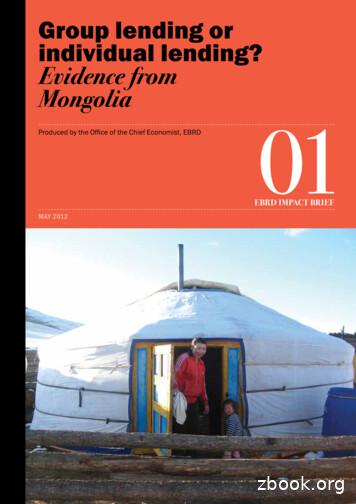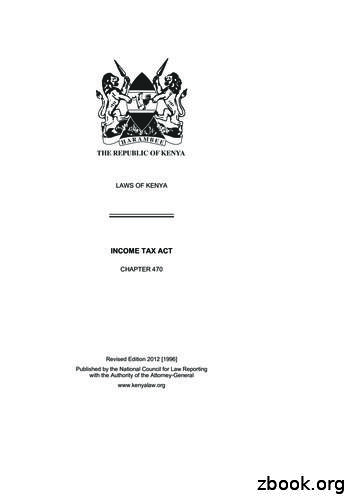V. Lending — Military Lending Act
V. Lending — Military Lending ActMilitary Lending ActBackgroundExaminers should reference the Military Lending Actexamination procedures (Chapter V-13.1 in the ComplianceExamination Manual) for consumer credit transactionsoccurring on or after October 3, 2016, as relevant. Forconsumer credit transactions occurring prior to these dates,examiners should reference the Talent Amendmentexamination procedures (Chapter V-12.1 in the ComplianceExamination Manual).The Military Lending Act 1 (MLA), enacted in 2006 andimplemented by the Department of Defense (DoD), protectsactive duty members of the military, their spouses, and theirdependents from certain lending practices. These practicescould pose risks for service members and their families, andcould pose a threat to military readiness and affect servicemember retention.The DoD regulation 2 implementing the MLA containslimitations on and requirements for certain types ofconsumer credit extended to active duty service membersand their spouses, children, and certain other dependents(“covered borrowers”). Subject to certain exceptions, theregulation generally applies to persons who meet thedefinition of a creditor in Regulation Z and are engaged inthe business of extending such credit, as well as theirassignees. 3For covered transactions, the MLA and the implementingregulation limit the amount a creditor may charge, includinginterest, fees, and charges imposed for credit insurance, debtcancellation and suspension, and other credit-relatedancillary products sold in connection with the transaction.The total charge, as expressed through an annualized ratereferred to as the Military Annual Percentage Rate (MAPR) 4may not exceed 36 percent. 5 The MAPR includes chargesthat are not included in the finance charge or the annualpercentage rate (APR) disclosed under the Truth in LendingAct (TILA). 6110 U.S.C. 987.32 CFR part 232.332 CFR 232.3(i).4The MAPR is calculated in accordance with 32 CFR 232.4(c).532 CFR 232.4(b).6The MAPR largely parallels the APR, as calculated in accordance withRegulation Z, with some exceptions to ensure that creditors do not haveincentives to evade the interest rate cap by shifting fees for the cost of thecredit product away from those categories that would be included in theMAPR. Generally, a charge that is excluded as a “finance charge” underRegulation Z also would be excluded from the charges that must be includedwhen calculating the MAPR. Late payment fees and required taxes—i.e.,fees that are not directly related to the cost of credit—are examples of itemsexcluded from both the APR and the MAPR. But certain other fees moredirectly related to the cost of credit are typically included in the MAPR, butnot the APR. The most common examples of these fees—application fees2In addition, among other provisions, the MLA, asimplemented by DoD: Provides an optional safe harbor from liability for certainprocedures that creditors may use in connection withidentifying covered borrowers; Requires creditors to provide written and oral disclosuresin addition to those required by TILA; Prohibits certain loan terms, such as prepayment penalties,mandatory arbitration clauses, and certain unreasonablenotice requirements; and Restricts loan rollovers, renewals, and refinancings bysome types of creditors.Statutory amendments to the MLA in 2013 grantedenforcement authority for the MLA’s requirements to theagencies specified in section 108 of TILA. 7 These agenciesinclude the Board of Governors of the Federal ReserveSystem, the Consumer Financial Protection Bureau (CFPB),the Federal Deposit Insurance Corporation, the NationalCredit Union Administration, the Office of the Comptrollerof the Currency, and the Federal Trade Commission. Stateregulators also supervise state-chartered institutions for MLArequirements pursuant to authority granted by state law.In July 2015, DoD published revisions to the MLAimplementing regulation 8 that: Extend the MLA’s protections to a broader range of creditproducts; Modify the MAPR to include certain additional fees andcharges; Alter the provisions of the optional safe harbor available tocreditors for identification of covered borrowers; Modify the disclosures creditors are required to provide tocovered borrowers; Modify the prohibition on rolling over, renewing, orrefinancing consumer credit; and Implement statutory changes, including provisions relatedto administrative enforcement and civil liability for MLAviolations (for knowingly violating the MLA, there ispotential for criminal penalties).and participation fees—have been specifically noted in the regulation ascharges that generally must be included in the MAPR, but would not beincluded in the APR under Regulation Z.7National Defense Authorization Act for Fiscal Year 2013, Pub. L. 112-239,section 662(b), 126 Stat. 1786.880 Fed. Reg. 43560.FDIC Consumer Compliance Examination Manual — September 2016V–13.1
V. Lending — Military Lending ActPreviously, the MLA regulation only applied to certain typesof credit, namely: narrowly defined payday loans, motorvehicle title loans, and tax refund anticipation loans withparticular terms. The current rule defines “consumer credit”subject to the MLA much more broadly, generally parallelingthe definition in Regulation Z. Some examples of additionalcredit products now subject to MLA protections when madeto covered borrowers include: Credit cards; Overdraft lines of credit (but not traditional overdraftservices); 9 and Certain installment loans (but not installment loansexpressly intended to finance the purchase of a vehicle orpersonal property when the credit is secured by the vehicleor personal property being purchased).Credit agreements that violate the MLA are void frominception. For most products, creditors are required to comeinto compliance with DoD’s July 2015 rule on October 3,2016. For credit card accounts, creditors are not required tocome into compliance with the rule until October 3, 2017. 10Definitions (§ 232.3)Consumer CreditConsumer credit is “credit offered or extended to a coveredborrower primarily for personal, family, or householdpurposes, and that is: Subject to a finance charge; or Payable by a written agreement in more than fourinstallments.”The MLA regulation’s definition of “consumer credit” hasbeen amended to align more closely with the definition of thesame term in Regulation Z. It is DoD’s intent that the termas used in the MLA regulation should wherever possible beinterpreted consistently with Regulation Z. Notably,An overdraft line of credit with a finance charge is a covered consumercredit product when: it is offered to a covered borrower; the credit extendedby the creditor is primarily for personal, family, or household purposes; it isused to pay an item that overdraws an asset account and for which thecovered borrower pays any fee or charge; and the extension of credit for theitem and the imposition of a fee were previously agreed upon in writing.10For purposes of the extended compliance date, the credit card accountsmust be under an open-end (not home-secured) consumer credit plan. DoDmay, by order, further extend the expiration of the limited exemption forcredit card accounts to a date not later than October 3, 2018. For all othercredit products, a creditor must comply with the applicable requirements ofthe July 2015 rule by October 3, 2016 for all consumer credit transactions oraccounts for consumer credit consummated or established on or after October3, 2016.V–13.2 Residential mortgages (any credit transaction secured byan interest in a dwelling), including transactions to financethe purchase or initial construction of a dwelling, anyrefinance transaction, a home equity loan or line of credit,or a reverse mortgage; Credit transactions expressly intended to finance thepurchase of a motor vehicle 11 when the credit is securedby the motor vehicle being purchased; and Deposit advance products;9however, the MLA and the implementing regulation do notapply to certain types of loans extended to covered borrowersthat are covered by Regulation Z, including: Credit transactions expressly intended to finance thepurchase of personal property when the credit is securedby the property being purchased.Note: A transaction where a creditor simultaneouslyextends an additional cash advance beyond the purchaseprice of the securing personal property does not fall underthis last exception.Covered BorrowerA covered borrower is a consumer who, at the time theconsumer becomes obligated on a consumer credittransaction or establishes an account for consumer credit, is acovered member of the armed forces or a dependent of acovered member (as defined in 32 CFR 232.3(g)(2) and(g)(3)).Covered members of the armed forces include members ofthe Army, Navy, Marine Corps, Air Force, or Coast Guardcurrently serving on active duty pursuant to title 10, title 14,or title 32 of the U.S. Code under a call or order that does notspecify a period of 30 days or fewer, or such a memberserving on Active Guard and Reserve duty as that term isdefined in 10 U.S.C. 101(d)(6).The term dependent refers to a covered member’s: Spouse; Children under age 21; Children under age 23 enrolled full-time at an approvedinstitution of higher learning and dependent on a coveredmember (or dependent at the time of the member’s orformer member’s death) for over one-half of their support;or11For purposes of the MLA, the term “vehicle” includes any self-propelledvehicle primarily used for personal, family, or household purposes for onroad transportation. The term does not include motor homes, recreationalvehicles (RVs), golf carts, or motor scooters.FDIC Consumer Compliance Examination Manual — September 2016
V. Lending — Military Lending Act Children of any age incapable of self-support due tomental or physical incapacity that occurred while adependent of the covered member under the preceding twobullets and dependent on a covered member (or dependentat the time of the member’s or former member’s death) forover one-half of their support.Other relationships may also qualify an individual as adependent of a covered member. Paragraphs (E) and (I) of10 U.S.C. 1072(2) reference other relationships that qualifyindividuals as dependents under the MLA.Per 32 CFR 232.2(a)(1), the regulation does not apply to acredit transaction or account relating to a consumer who isnot a covered borrower at the time that he or she becomesobligated on a credit transaction or establishes an account forcredit. Additionally, the regulation does not apply to a credittransaction or account (which would otherwise be consumercredit) relating to a consumer once the consumer no longer isa covered borrower.CreditorExcept as provided in 32 CFR 232.8(a), (f), and (g), acreditor under the MLA is a person who is: Engaged in the business of extending consumer credit; 12 or An assignee of a person engaged in the business ofextending consumer credit with respect to any consumercredit extended.With respect to 32 CFR 232.8(a) only (relating to limitationson rollovers, renewals, repayments, refinancings, andconsolidations), the term creditor means a person engaged inthe business of extending consumer credit subject toapplicable law to engage in deferred presentmenttransactions or similar payday loan transactions. However,pursuant to 232.8(a), the term does not include a person thatis chartered or licensed under Federal or State law as a bank,savings association, or credit union.With respect to 32 CFR 232.8(f) only (relating to limitationson the use of a vehicle title as security), the term creditordoes not include a person that is chartered or licensed underFederal or State law as a bank, savings association, or creditunion.With respect to 32 CFR 232.8(g) only (relating to limitationson requiring establishment of an allotment as a condition forextending credit), the term creditor does not include a“military welfare society,” as defined in 10 U.S.C.12For the purposes of this definition, a creditor is engaged in the business ofextending consumer credit if the creditor considered by itself and togetherwith its affiliates meets the transaction standard for a “creditor” underRegulation Z with respect to extensions of consumer credit to coveredborrowers.1033(b)(2), or a “service relief society,” as defined in 37U.S.C. 1007(h)(4).Military Annual Percentage Rate (MAPR)The MAPR is the cost of the consumer credit expressed as anannual rate, calculated in accordance with 32 CFR 232.4(c)(see “Terms of Consumer Credit Extended to CoveredBorrowers (Calculation of MAPR) (§ 232.4)” for moreinformation about calculating the MAPR). The MAPR forcovered transactions must not exceed 36 percent. 13Short-Term, Small Amount LoanUnder certain circumstances, an application fee for a shortterm, small amount loan may be excluded when calculatingthe MAPR (see “Terms of Consumer Credit Extended toCovered Borrowers (Calculation of MAPR) (§ 232.4)” formore information about calculating the MAPR). A shortterm, small amount loan is a closed-end loan that is: Subject to and made in accordance with a Federal law(other than the MLA) that expressly limits the rate ofinterest that a Federal credit union or an insured depositoryinstitution may charge on an extension of credit, providedthat the limitation set forth in that law is comparable to alimitation of an annual percentage rate of interest of 36percent; and Made in accordance with the requirements, terms, andconditions of a rule, prescribed by the appropriate Federalregulatory agency (or jointly by such agencies), thatimplements the Federal law described in the paragraphabove, provided further that such law or rule contains:oA fixed numerical limit on the maximum maturityterm, which term shall not exceed nine months; andoA fixed numerical limit on any application fee thatmay be charged to a consumer who applies for suchclosed-end loan.Terms of Consumer Credit Extended to CoveredBorrowers (Calculation of MAPR) (§ 232.4)Types of Fees to Include in MAPR CalculationUnder the MLA, a creditor may not impose an MAPRgreater than 36 percent in connection with an extension ofconsumer credit that is closed-end credit or in any billingcycle for open-end credit. For credit card accounts, creditors13The regulation also prohibits an institution from imposing an MAPRexcept as authorized by applicable Federal or State law. Depending on thetype of institution, different Federal or State laws may govern the maximumrates and fees an institution may impose for consumer credit transactionscovered by the regulation, but in no instance may such rates and fees exceedthe 36-percent MAPR cap contained in the regulation.FDIC Consumer Compliance Examination Manual — September 2016V–13.3
V. Lending — Military Lending Actare not required to comply with DoD’s July 2015 rule untilOctober 3, 2017.under Regulation Z based on the MAPR charges listedabove. See Examination Checklist for the types of fees thatwould be included or excluded from the MAPR calculation.The following charges included in the MAPR (“charges”)must be included in the calculation of the MAPR for bothclosed- and open-end credit, as applicable:Computing the MAPR for Open-End Credit Any credit insurance premium or fee, any charge forsingle premium credit insurance, any fee for a debtcancellation contract, or any fee for a debt suspensionagreement;Generally, the MAPR for open-end credit should becalculated following the rules for calculating the effectiveannual percentage rate for a billing cycle as set forth in 12CFR 1026.14(c) and (d) of Regulation Z 14 (as if a creditormust comply with that section) based on the charges listedabove. Any fee for a credit-related ancillary product sold inconnection with the credit transaction for closed-end creditor an account for open-end credit; and Except for a bona fide fee (other than a periodic rate)charged to a credit card account, which may be excluded ifthe bona fide fee is reasonable:oFinance charges associated with the consumercredit;oAny application fee charged to a covered borrowerwho applies for consumer credit, other than anapplication fee charged by a Federal credit union oran insured depository institution when making ashort-term, small amount loan provided that theapplication fee is charged to the covered borrowernot more than once in any rolling 12-month period(see note below); andoIn general, any fee imposed for participation in anyplan or arrangement for consumer credit. (See “NoBalance During a Billing Cycle” section below formore information on the MAPR calculation ruleswhen there is no balance during a billing cycle foropen-end credit).These charges are to be included in the MAPR calculationeven if they would be excluded from the calculation of thefinance charge under Regulation Z.Note: One application fee charged by a creditor making ashort-term, small amount loan can be excluded from thecomputation of the MAPR under the conditions noted in thedefinition of a short-term, small amount loan. However, if acreditor charges a second application fee to a coveredborrower who applies for a second short-term, small amountloan within a rolling 12-month period, then that second fee(and any subsequent application fees charged during thatperiod) is not eligible for the exclusion and must be includedwhen computing the MAPR for that loan.Computing the MAPR for Closed-End CreditFor closed-end credit, the MAPR shall be calculatedfollowing the rules for calculating and disclosing the“Annual Percentage Rate (APR)” for credit transactionsV–13.4Even if a fee is otherwise eligible to be excluded under 12CFR 1026.14(c) and (d), the amount of charges related toopening, renewing, or continuing an account must beincluded in the calculation of the MAPR to the extent thosecharges are among those in the above “Types of Fees toInclude in MAPR Calculation”.No Balance During a Billing Cycle. For open-end credit, ifthe MAPR cannot be calculated in a billing cycle becausethere is no balance in the billing cycle, a creditor may notimpose any fee or charge during that billing cycle, exceptthat the creditor may impose a fee for participation in anyplan or arrangement for that open-end credit so long as theparticipation fee does not exceed 100.00 annually,regardless of the billing cycle in which the participation feeis imposed.Note: the 100.00-per-year limitation on the amount of theparticipation fee does not apply to a bona fide participationfee charged to a credit card account consistent with 32 CFR232.4(d).Creditors may impose fees or charges that are excluded fromthe calculation of the MAPR during a particular billing cyclewhere there is no balance during the billing cycle. Forexample, if a creditor charged a late fee for a late payment inaccordance with its credit agreement with the coveredborrower and in compliance with Regulation Z, the creditormay charge the fee, regardless of whether there is a balancein the billing cycle, because a late fee is not among thecharges that are included in the calculation of the MAPR.Bona Fide Fees Charged to a Credit Card Account,Generally. For consumer credit extended in a credit cardaccount under an open-end (not home-secured) consumercredit plan, a bona fide fee, other than a periodic rate, is not acharge required to be included in the MAPR calculation,14Sections 1026.14(c) and (d) of Regulation Z provide for the methods ofcomputing the APR under several scenarios, such as: (1) when the financecharge is determined solely by applying one or more periodic rates; (2) whenthe finance charge during a billing cycle is or includes a fixed or other chargethat is not due to application of a periodic rate, other than a charge withrespect to a specific transaction; and (3) when the finance charge during abilling cycle is or includes a charge relating to a specific transaction duringthe billing cycle.FDIC Consumer Compliance Examination Manual — September 2016
V. Lending — Military Len
The Military Lending Act. 1 (MLA), enacted in 2006 and implemented by the Department of Defense (DoD), protects active duty members of the military, their spouses, and their dependents from certain lending practices. These practices coul
Group-lending villages Individual-lending villages Control villages Uvs Khovsgol Bulgan Khentii Ulaanbaatar Arkhangai Group-lending villages Individual-lending villages Control villages 04 The experiment Mongolia is the most sparsely populated country in the world and this makes disbursing, monitoring and collecting small loans very costly.
6 of 2001, Act No. 7 of 2002, Act No. 15 of 2003, Act No. 4 of 2004, Act No. 6 of 2005, Act No. 10 of 2006, Act No. 9 of 2007, Act No. 8 of 2008, Act No. 8 of 2009, Act No. 10 of 2010, Act No. 4 of 2012.] PART I - PRELIMINARY 1. Short title and commencement This Act may be cited as the Income Tax Act, 1973 and shall, subject to the
Fair lending guarantees the same lending opportunities to everyone. Is there a law that protects my fair lending rights? Yes. The federal Fair Housing Act protects your fair lending. rights. The Oice of Fair Housing and Equal Opportunity. enforces the federal Fair Housing Act and state and local enforcement agencies enforce fair housing laws .
Navy This branch of our nation’s armed services conducts military operations at sea, world-wide. According to the Department of Defense, its focus is “maintaining the freedom of the seas, deterring aggression, and achieving victory at war.” Like the Air Force, the Navy has many aircraft to assist with protecting the seas.File Size: 959KBPage Count: 12Explore furtherUnderstanding the 5 Branches of US Military - US Militaryusmilitary.comBasic Branches of the United States Armylibarts.hamptonu.eduU.S. National Military Chain-of-Commanddde.carlisle.army.milArmy Branches Military Science - SOU Homeinside.sou.eduWhat Are the Branches of the US Military? Military.comwww.military.comRecommended to you b
Supersedes: AFI36-2608, 26 October 2015 Certified by: SAF/MR (Mr. John A. Fedrigo) Pages: 140 This instruction implements Department of Defense Instruction (DoDI) 1336.08, Military Human Resource Records Life Cycle Management, and is consistent with DAFPD 36-25, Military Promotion and Demotion. It applies to all military and civilian members of .File Size: 1MBPage Count: 176Explore furtherAFI 36-2608 Military Personnel Records System Air Force .www.airforcecounseling.comAFI 36-2608 Military Personnel Records System Air Force .www.airforcecounseling.comAFI 36-2608 - MILITARY PERSONNEL RECORDS SYSTEMS .standards.globalspec.comAIR FORCE - AFI 36-2608 - MILITARY PERSONNEL RECORDS .standards.globalspec.comAIR FORCE - AFI 36-2608 - MILITARY PERSONNEL RECORDS .standards.globalspec.comRecommended to you based on what's popular Feedback
Act I, Scene 1 Act I, Scene 2 Act I, Scene 3 Act II, Scene 1 Act II, Scene 2 Act II, Scene 3 Act III, Scene 1 20. Act I, Scene 1–Act III, Scene 1: Summary . Directions: Summarize what you what you have read so far in Divided Loyalties (Act I-Act III, Scene1). 21. Act III, Scenes 2 and 3:
LAW BOOK Act 358 of 1955 As Amended By Act 490 of 1961 Act 403 of 1965 Act 400 of 1969 Act 566 of 1973 Acts 532 & 644 of 1975 Act 465 of 1987 Act 1228 of 1991 Act 1056 of 1993 Act 771 of 1995 Act 512 of 1997 Acts 595,596 & 680 of 2003 Act 207 of 2005 Act 223 of 2007 Issued by ARKANSAS STAT
course. The course was advertised as a training for social and philanthropic work. Birmingham was the first UK University to give aspiring social workers full status as students. From its founding in 1900 University staff had been actively involved in social welfare and philanthropic work in the City of Birmingham. Through research into the employment and housing conditions of poor people in .























